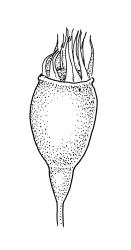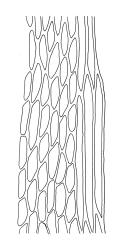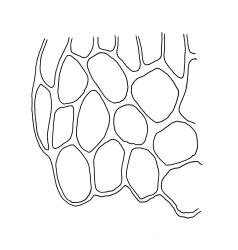- ≡ Neckera splachnoides Sm., Engl. Bot. 36, 2564 (1813)
- = Daltonia novae-zelandiae Mitt., J. Proc. Linn. Soc., Bot. 4: 95 (1859)
Daltonia angustifolia sensu Sainsbury (1955)
Plants small, yellow-green to golden, forming tufts on small branches or twigs. Stems mostly simple, soft, c. 3–6(–10) mm, in cross-section with large and thin-walled internal cells, hyaloderm, distinct cortical layers, and a central strand all absent, beset with finely papillose, red-brown rhizoids. Shoots c. 2.5–3 mm wide, neither flattened nor secund. Leaves erect and straight when moist, weakly spirally twisted around stem or weakly contorted when dry, weakly or not keeled, neither complanate nor secund, linear-lanceolate, acuminate, recurved at both margins, mostly 1.5–2.5 mm; upper laminal cells smooth, firm-walled, linear-rhombic to ± hexagonal, 21–27(–36) × 6–8 µm, becoming gradually longer below (mostly c. 30–38 µm at mid leaf); basal laminal cells ± linear-rhombic to oblong, thin-walled, non-porose, a single row at extreme leaf base pigmented; alar cells not differentiated; border of c. 5 rows of thick-walled and linear cells at mid leaf, tapered to a single row near apex. Costa single, narrow, unforked, ending well below the leaf apex. Propagulae sometimes present in leaf axils, fusiform, c. 100–125 µm, transversely septate and mostly 5-celled. Axillary hairs not seen.
Autoicous. Perichaetial leaves ovate, acute, scarcely bordered, weakly costate, c. 0.6–0.7 mm. Perigonia scattered on stems, lacking paraphyses, with strongly concave, ovate, ± yellow bracts, c. 0.7 mm. Setae borne laterally, scabrous above, smooth below, c. 3–7 mm, red-brown, weakly twisted (apparently in either direction); capsules erect, symmetric, oblong-cylindric from a distinct and tapered neck, c. 0.6–0.8 mm; exothecial cells with bulging cell walls and weakly collenchymatous; operculum short-rostrate from a conic base. Peristome white or pale yellow under the stereoscope, inserted at the mouth; exostome teeth and endostome as per genus. Calyptra as per genus, enclosing the operculum and c. ⅓ of the urn. Spores variably sized in a single capsule, (12–)14–18(–24) µm, very finely papillose.
Sainsbury 1955, pl. 63, fig. 4. Streimann 2000, fig. 15; Smith 2004, fig. 231, 1–3.
Daltonia splachnoides is sometimes confused with species of Crosbya. Daltonia splachnoides is a much smaller, softer, and more delicate plant (stems mostly c. 3–6 mm and fragile) compared to Crosbya straminea (stems mostly c. 20–35 mm and rigid). The costae in D. splachnoides end well below the leaf apices, while those in C. straminea are subpercurrent to short-excurrent. The scabrous setae and erect symmetric capsules here contrast with the smooth setae and inclined capsules in C. straminea. In D. splachnoides the exostome teeth lack a median furrow, are finely baculate throughout, and lack marginal trabeculae while in C. straminea the teeth are narrowly furrowed, cross-striate, and trabeculate at margins. The two taxa also differ in their sexuality and clearly deserve placement in different genera.
Confusion is more likely between D. splachnoides and Crosbya nervosa. Daltonia splachnoides leaves have a narrow costa ending well below the apex, differentiated borders c. 5 rows of cells wide at mid leaf and tapered to a single row near the leaf apex, and erect capsules (c. 0.6–0.8 mm), with a distinct, tapered, and non-tuberculate neck. These features contrast with, in C. nervosa, a stout excurrent costa that fuses with the margins to form a cusp, leaf borders 3–5 cells wide at mid leaf and not tapered toward the leaf apex, and weakly inclined capsules (c. 1.3 mm) with a tapered and strongly tuberculate neck. Daltonia splachnoides lacks an endostomal basal membrane while C. nervosa has a well-developed endostomal membrane. The relationship between these two species deserves further study.
Scott & Stone (1976, pp. 388, 396) suggested D. splachnoides could be confused with Sauloma tenella. All of the following features of D. splachnoides contrast sharply with S. tenella: erect stems, linear-lanceolate leaves with non-reflexed apices; much stronger and non-bifurcate costae; upper laminal cell dimensions; capsule orientation; peristome colour and ornamentation; and the nature of the calyptrae.
NI: N Auckland (Waipoua, Hunua Range), S Auckland, Gisborne (Moanui Conservation Area, Rākauroa Scenic Reserve, Hopuruahine River), Hawke’s Bay (Mōrere), Wellington; SI: Nelson, Westland, Otago (Pūrākaunui Falls), Southland (Lake Manapōuri, Milford Sound); St.
Anomalous. Tasmania*. Recorded from mainland Australia (Vic. and Qld) by Streimann 2000. Recorded from the British Isles (where it is "very rare") and "China, Madeira, Azores, Fernando Pó, western N. America, Mexico, [and] Antilles" by Smith (2004, p. 703). Daltonia angustifolia Dozy & Molk. is probably conspecific and is widespread in south-east Asia.
Most often collected from twigs and small branches in hyper-moist but insolated scrublands or forest margins. Less frequently on tree trunks or epiphyllic on fern fronds (e.g., Dicksonia fibrosa). Host species are varied and include Aristotelia serrata, Carpodetus serratus, several Coprosma spp., Fuchsia excorticata, Hoheria sp., Leptospermum scoparium, Melicytus ramiflorus, Muehlenbeckia complexa, Neomyrtus pedunculata, Pseudopanax arboreus, and Weinmannia racemosa. Also on nīkau palm (Rhopalostylis sapida) and cabbage tree (Cordyline australis) and recorded from twigs of introduced species of Crataegus and Salix. On the North I. from c. 140 m to at least 680 m (Rākauroa Scenic Reserve); on the South I. from near sea level (Fox River, Nelson L.D.) to c. 500 m (Duffy Creek, Nelson L.D.). The most frequently associated species are Tetraphidopsis pusilla and Metzgeria spp.; the wide range of other associated species include Calyptopogon mnioides, Calyptrochaeta flexicollis, Cladomnion ericoides, Ephemeropsis trentepohlioides, Macromitrium spp., Alleniella hymenodonta, Orthotrichum calvum, Rhaphidorrhynchium amoenum, Ulota lutea, Weymouthia mollis, and Leptogium spp.
Streimann’s (2000) decision to apply the Irish name D. splachnoides to Australasian material is accepted here. Streimann (p. 128) expressed the opinion the predominantly Asian D. angustifolia would prove to be synonymous with D. splachnoides. Although there is considerable variation in vegetative leaf length, I agree with Streimann that there is no clear morphological discontinuity between these two species that would justify taxonomic segregation. Sainsbury and other 20th century N.Z. workers referred the bulk of N.Z. Daltonia to D. angustifolia Dozy & Molk.











